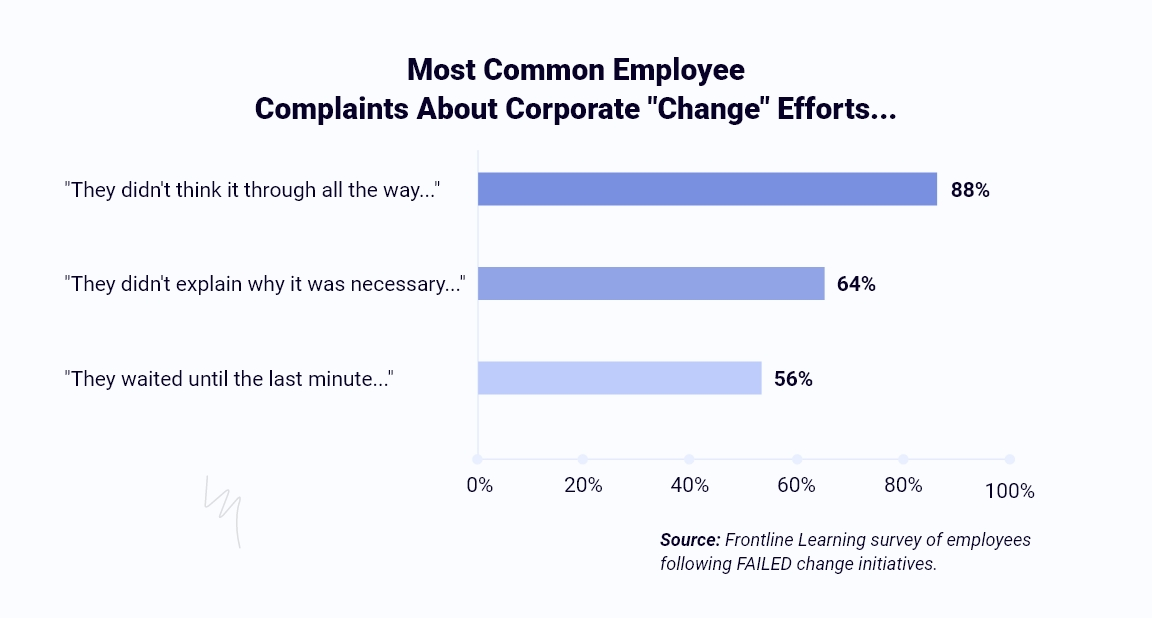Change management is a roadmap for guidance through organizational transitions—propelling us forward from where we are now to where we want to be. It’s about planning, making changes, and ensuring everyone’s on board to reach common goals without too much pushback. In the business world, change is always happening—new tech, market fluctuations, you name it. So, being adaptable and resilient is crucial for navigating through these unknowns.
And you know what they say—change is the only constant. Leaders get that. Whether it’s tech getting fancier or markets doing the cha-cha, being able to roll with the punches is key.
This theme was central to the discussion at our leadership webinar session, graced by three highly accomplished experts: Malisa Chambliss, Senior Vice President and CHRO at StandardAero; Kevin McFadden, Corporate Training Manager at POWER Engineers; and Dan Rust, Head of Global Leadership and Organizational Development at Infopro Learning.
Unveiled in this insightful webinar of ‘Resilience to Navigate Change,’ industry leaders revealed their success mantra for doing just that, shared inspiring success stories, and showcased real-life examples of remarkable resilience amidst adversity. Watch the replay here.
Common Complaints in Change Initiatives: A Look from Employee Perspectives
Whether we like it or not, the world around us always evolves. The question is how well we can navigate through these changes. Our ability to adapt doesn’t just affect one part of our lives – it has a ripple effect on almost everything.
Imagine being stuck, unable to flex and respond to the changes around us. It becomes a constant burden because the world keeps moving forward, and we must keep up.
Here are some results from the Frontline Learning survey of employees, specifically those from companies that went through major change initiatives that didn’t quite go as planned. They call it “FAILED,” but not every change sticks.

When employees were asked about failed change initiatives at their companies, they shared three common complaints:
1. Poor planning: Employees felt that the change initiatives were poorly thought out and didn’t consider all the possible consequences.
2. Lack of communication: Employees were not told why the changes were necessary or the benefits.
3. Late implementation: The changes were implemented too late, which made it difficult for employees to adjust.
These complaints highlight the importance of careful planning, clear communication, and timely implementation when making changes at work.
Learning from Missteps: Insights into Major Errors in Change Initiatives
Malisa, Kevin and Dan, drawing from their own experiences, provided anecdotes of change management missteps.
When implementing change, it is crucial to overestimate the amount and depth of communication needed. Having been involved in the change process for an extended period, leaders may overlook the need for thorough communication. However, employees require comprehensive information to understand the change and its implications. Malisa said that effective communication should address the “who, what, why, where, how, and when” aspects of the change, allowing employees to comprehend the situation and adjust accordingly.
Building on Melissa’s point, Dan expanded to say that organizations often fall into the trap of relying on a single communication, such as a detailed email or video, to convey significant change initiatives. After months of internal discussions and preparations, they believe a single communication should suffice. However, they fail to recognize the need for ongoing repetition and reinforcement to ensure the organization fully comprehends and embraces the change. This one-time communication approach often results in confusion, resistance, and a failure to adopt the desired change.
Furthermore, Kevin reflected on stakeholders’ often unrealistic expectations regarding change management and its effectiveness. He acknowledges increasing dissatisfaction, emphasizing the limited scope of addressing variables in a dynamic environment. Despite believing in change management, he notes that the term wasn’t common a decade ago, and some leaders may not fully grasp its nuances. Kevin stresses the need for upfront time investment to align expectations. He dispels the misconception that training alone constitutes change management, highlighting the importance of a collaborative team effort involving leadership and stakeholders. Kevin also underscores the emotional difficulty of change, urging a focus on the human factor.
In the upcoming section, we explore the strategy leaders are suggested to employ when steering change, per the collective viewpoint of industry experts.
Involving Employees: Key to Successful Change Planning
Malisa says involving diverse employees in planning and implementing change initiatives is crucial. Leaders sometimes make the error of making decisions without talking to the people who will be affected by the changes. This can lead to errors and mistakes, as leaders may not be aware of all the nuance and details necessary to make informed decisions. Moreover, individuals are inclined to embrace change when they sense inclusion. Leaders must put more effort into explaining the “why” behind the change and ensuring employees feel heard.
Dan seconded Malisa’s opinion and added that even if the people involved in the dialogue don’t have direct control over the change, they will still feel a sense of ownership and control if they are part of the conversation. This is much different than simply delivering a change initiative to the rest of the organization without their input. Leaders need to be careful not to lie to their employees about upcoming changes. This can erode trust and create challenges for implementing future changes.
The negative repercussions of misleading employees on a change, as highlighted by Kevin, are emphasized further. The downstream impact of the decision to provide inaccurate information to the employees is deemed significant. This misstep is anticipated to have lasting effects on the company over the coming years due to a breach of trust. Looking ahead just 12 months, in the event of another major change initiative, the credibility of information from management or higher-ups may face skepticism. The immediate impact is evident, but the substantial repercussions extend to second and third-order effects, making it a critical issue.
Within Infopro Learning, our leadership development experts oversee two change-focused programs. Our change acceleration process is tailored to support organizations implementing extensive transformations.
Are you searching for leadership development programs for your current and aspiring leaders? Feel free to contact us at info@infoprolearning.com or leave a comment below.




